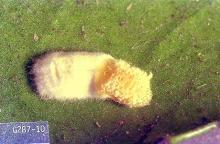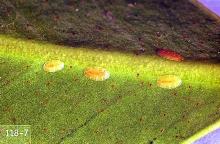Pulvinaria floccifera
See:
Pest description and crop damage The cottony camellia scale is a flat, brownish or yellowish insect. Crawlers (young scale) feed on the underside of leaves. Cottony camellia scale produce large amounts of honeydew, a sweet sticky material which is often covered with a growth of black sooty mold. Foliage with scale infestations may turn yellowish or pale in color. The cottony camellia scale also is found on yew and holly.
Biology and life history The scale overwinter on twigs or evergreen leaves as nymphs. In the spring, adult females lay cottony egg masses about 0.25 inch long on the underside of leaves. The eggs hatch, and the crawlers settle on the leaves to feed. There is one generation per year.
Scouting and thresholds Inspect twigs during the dormant season for scale. Pay particular attention to weak plants. The crawlers are best observed during May to July with a 10X magnifying glass.
Management-chemical control
Most favorable period for control is in late summer or early fall after eggs have hatched.
See:
Chemical Control of Nursery Pests
For more information
Johnson, W.T. and H.H. Lyon (1991), Insects That Feed on Trees and Shrubs, 2nd ed., Cornell University Press (p. 344).
PNW Nursery IPM: Cottony camellia scale (https://agsci.oregonstate.edu/nurspest/insects/cottony-camellia-scale)




